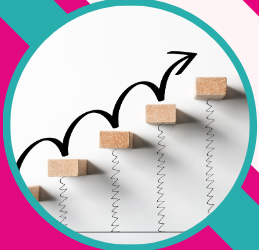Our research has found that using marketing metrics effectively is the number one pain point for UK SMEs. In fact, only 27% of SMEs set clear objectives when using specialist marketing services, and just 41% measure the profitability of their customers.
To dig deeper into why SMEs are facing these issues and how they can overcome them, we spoke with Lindsay Ball, one of our Marketing Directors in the East Midlands.
Why UK SME owners struggle with marketing metrics
“My clients are often great with data,” Lindsay told us. “They can wax lyrical on the core metrics for their business—how many sales they’re expecting, how many products they can get out of a sheet of metal. But where they get unstuck is understanding how marketing metrics relate to their business.”
It’s easy to open Google Analytics or your CRM and gather data. But how does that data relate to your marketing and sales funnel? What is it telling you about your overall commercial performance?
“People often focus on the metrics that are easiest to access—like time on page or open rates—because they’re easy to get. The problem is, those numbers don’t tell you much in reality. Just because someone spent 10 minutes on your website doesn’t mean they’re any closer to making a purchase.”
Rather than starting with metrics, business leaders should start by mapping out the entire customer journey. This involves:
- Mapping out the process from customers having a business need, hopefully, hearing about you for the very first time, through to becoming a repeat customer and advocate for your business
- Detailing the customer’s needs and expectations as they progress through the process
- Mapping out what you need to do to meet their needs and help them progress to the solution
Once that has been mapped out, then you can assign sensible metrics to the different stages.
"It’s common sense really. Once you understand your customer journey - the stages, the touchpoints, the blockers - you can choose metrics that really matter. But without knowing the journey, or what parts of the journey you’re really measuring, metrics in isolation tell you little.”
Real-world examples of using marketing metrics to solve business problems
By mapping out the full journey—from the first point of contact to the final sale—businesses can uncover where leads drop off and see what needs to be fixed.
We asked Lindsay to share a couple of real-life examples with us.
Missed appointments and low lead conversion for a fertility clinic
“A few years ago I worked with a fertility clinic that was great at tracking their impressive medical outcomes, but their growth did not reflect this success. Largely because the Board had no visibility of their marketing and sales metrics,” Lindsay told us.
She helped them map out and measure the entire patient journey. They discovered that many potential enquirers dropped out just before their initial Doctor consultation, probably due to nerves or finances.
"People were cancelling two days before their consultations because they were scared. This is a big emotional and financial decision—£7,000 to £10,000 for treatment—and they weren’t ready. By pushing too fast, the clinic was creating a false economy with doctors sitting around with empty diaries."
To reassure customers, they introduced an email sequence that nurtured and reassured them by offering more information on the process coupled with testimonials and a complimentary 20-minute consultation with a well-trained customer service team who could answer questions on a zero-obligation basis.
These changes reduced cancellations by 18% and improved the overall conversion to booking by 10%. The changes also identified that the key metrics for this business were early in the customer qualification process.
Low customer retention and missed opportunities for a car dealership
“I was working with a car dealership who knew that they had high levels of enquiries but that their close rate and retention was poor. They couldn’t tell what was going wrong and why.”
Lindsay worked with the business to map out the customer journey, from the moment customers first learned about the brand to the point of signing a lease. They identified that customers were dropping off after the point of first contact where they were transferred to a broker because the process seemed too complex and impersonal.
By simplifying the journey, offering personalised touchpoints and providing relevant content earlier in the decision-making process, they were able to guide customers through the process. Customers preferred to deal with one contact and develop trust.
“By tracking conversion rates and customer retention at every stage, we could see where improvements were needed and what wasn’t working. Also, the brokers loved it - quality leads with fewer ‘tyre kickers’. Once you can see where things are going wrong, finding solutions is relatively easy.”
How to get started with marketing metrics
If you’re feeling overwhelmed by metrics, the best place to start is by mapping out your customer journey. Break down the process into clear stages—from initial awareness of your business to making a purchase—and think strategically about what you could measure at each step to understand if it’s going well or not.
Here are a few tips to get you started:
- Map the buyer journey: Break down each stage from awareness to purchase. Understand the different touchpoints where a potential customer interacts with your business. Follow the process through from hearing about you for the first time to becoming a repeat customer and recommending you to others.
- Assign relevant metrics: For each stage, choose metrics that give you insights into how well that step is performing. For example, at the awareness stage, you might track website visits, while at the purchase stage, you might track close rates and the average length of the sales cycle.
- Stay focused on what matters: The more metrics you try to focus on, the less likely you are to succeed. Pick key metrics for each stage and don’t overwhelm yourself by choosing too many.
As Lindsay puts it, "Metrics are useful when they help you understand where people are dropping off in the customer journey and why. If you can fix those leaks, you’ll see the impact on your bottom line."
Marketing metrics are powerful tools when used correctly
Marketing metrics don’t have to be a headache. By starting with the customer journey and thinking strategically about what you want to measure and how best to do that, you can identify and resolve critical problems you may not know you have.
Our team of Marketing Directors have experience helping hundreds of SMEs across the UK to understand their marketing data. If you could use an outside perspective, get in touch today.




